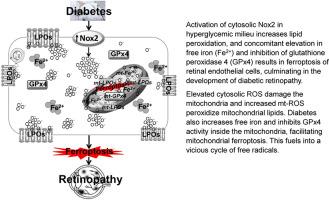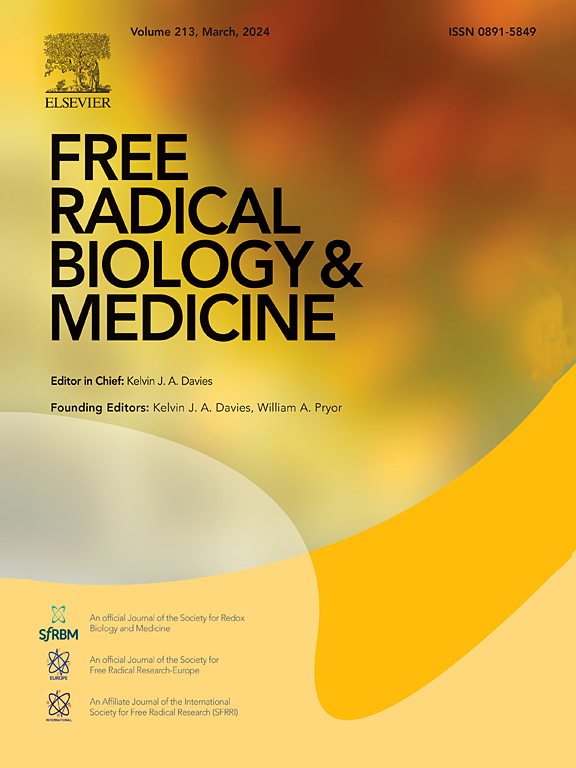铁蛋白沉积在糖尿病视网膜病变线粒体损伤中的作用。
IF 7.1
2区 生物学
Q1 BIOCHEMISTRY & MOLECULAR BIOLOGY
引用次数: 0
摘要
糖尿病视网膜病变是由氧化应激-线粒体损伤引起的。糖尿病患者的细胞膜 NADPH 氧化酶 2(Nox2)在视网膜线粒体损伤之前就会激活产生 ROS 的细胞膜,从而引发自由基的恶性循环。ROS 水平升高会使膜脂过氧化,增加破坏性脂质过氧化物(LPO)。虽然谷胱甘肽过氧化物酶 4(GPx4)能中和 LPO,但其生成-中和失衡会导致铁中毒,其特征是 LPO、游离铁增加和 GPx4 活性降低。线粒体富含多不饱和脂肪酸和铁,并具有线粒体同工型 GPx4。我们的目的是研究糖尿病视网膜病变中的线粒体铁变态反应,重点是 Nox2 介导的 ROS 生成。使用人视网膜内皮细胞,在 5mM 或 20mM D-葡萄糖中培养 12 至 96 小时,使用或不使用 Nox2 抑制剂(100μM apocynin、5μM EHop-016 或 5μM Gp91 ds-tat),或铁氧化抑制剂(1μM ferrostatin-1, 50μM deferoxamine)或激活剂(0.1μM的RSL3)、细胞膜和线粒体ROS、LPO、铁、GPx4活性、线粒体完整性(膜通透性、耗氧量、mtDNA拷贝数)和细胞死亡进行量化。虽然 Nox2 和铁变态反应抑制剂阻止了葡萄糖诱导的铁变态反应标志物的增加,但线粒体损伤和细胞死亡(RSL3)进一步恶化了这些标志物。此外,高糖还会增加线粒体中的铁变态标志物,而线粒体中的铁变态标志物会随着细胞膜中的铁变态标志物的增加而增加,这表明细胞膜 ROS 在线粒体铁变态中的作用。因此,以Nox2-铁跃迁为靶点应有助于打破由受损线粒体引发的自由基自我循环的恶性循环,并能为预防/延缓糖尿病视网膜病变的发展提供新的疗法。本文章由计算机程序翻译,如有差异,请以英文原文为准。

Role of ferroptosis in mitochondrial damage in diabetic retinopathy
Diabetic retinopathy is driven by oxidative stress-mitochondrial damage. Activation of ROS producing cytosolic NADPH oxidase 2 (Nox2) in diabetes precedes retinal mitochondrial damage, initiating a vicious cycle of free radicals. Elevated ROS levels peroxidize membrane lipids increasing damaging lipid peroxides (LPOs). While glutathione peroxidase 4 (GPx4) neutralizes LPOs, an imbalance in its generation-neutralization leads to ferroptosis, which is characterized by increased LPOs, free iron and decreased GPx4 activity. Mitochondria are rich in polyunsaturated fatty acids and iron and have mitochondrial isoform of GPx4. Our aim was to investigate mitochondrial ferroptosis in diabetic retinopathy, focusing on Nox2 mediated ROS production. Using human retinal endothelial cells, incubated in 5 mM or 20 mM D-glucose for 12–96 h, with or without Nox2 inhibitors (100 μM apocynin, 5 μM EHop-016 or 5 μM Gp91 ds-tat), or ferroptosis inhibitors (1 μM ferrostatin-1, 50 μM deferoxamine) or activator (0.1 μM RSL3), cytosolic and mitochondrial ROS, LPOs, iron, GPx4 activity, mitochondrial integrity (membrane permeability, oxygen consumption rate, mtDNA copy numbers) and cell death were quantified. High glucose significantly increased ROS, LPOs and iron levels and inhibited GPx4 activity in cytosol, and while Nox2 and ferroptosis inhibitors prevented glucose-induced increase in ferroptosis markers, mitochondrial damage and cell death, RSL3, further worsened them. Furthermore, high glucose also increased ferroptosis markers in the mitochondria, which followed their increase in the cytosol, suggesting a role of cytosolic ROS in mitochondrial ferroptosis. Thus, targeting Nox2-ferroptosis should help break down the self-perpetuating vicious cycle of free radicals, initiated by the damaged mitochondria, and could provide novel therapeutics to prevent/retard the development of diabetic retinopathy.
求助全文
通过发布文献求助,成功后即可免费获取论文全文。
去求助
来源期刊

Free Radical Biology and Medicine
医学-内分泌学与代谢
CiteScore
14.00
自引率
4.10%
发文量
850
审稿时长
22 days
期刊介绍:
Free Radical Biology and Medicine is a leading journal in the field of redox biology, which is the study of the role of reactive oxygen species (ROS) and other oxidizing agents in biological systems. The journal serves as a premier forum for publishing innovative and groundbreaking research that explores the redox biology of health and disease, covering a wide range of topics and disciplines. Free Radical Biology and Medicine also commissions Special Issues that highlight recent advances in both basic and clinical research, with a particular emphasis on the mechanisms underlying altered metabolism and redox signaling. These Special Issues aim to provide a focused platform for the latest research in the field, fostering collaboration and knowledge exchange among researchers and clinicians.
 求助内容:
求助内容: 应助结果提醒方式:
应助结果提醒方式:


